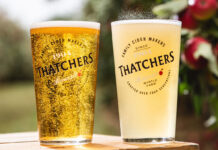New twists on classic serve are helping to grow consumer interest in category

WHILE gin has played a prominent role in the recent cocktail boom, and continues to prove popular with bartenders for mixing, there are simpler ways for pubs to capitalise on the spirit’s growing popularity.
Drinks companies have told SLTN that offering consumers a fresh twist on the classic gin and tonic serve is one of the best ways to attract new and lapsed consumers to the category.
James Hayman, director of Hayman Distillers, said the gin and tonic has become “very popular” again, which he attributed to improved quality of serve in outlets.
“You’re unlikely to get a ‘watery’ gin and tonic these days which, due to crushed ice or sub-standard mixers, often used to be a risk,” said Hayman.
“Likewise, bartenders are far more aware now of the importance of the correct glassware and garnishes.”
The quality of gin and tonic serve has been a recent focus for Diageo, the company behind the Gordon’s and Tanqueray brands.
Commercial manager David McGowan said quality of serve and promoting the gin and tonic around key occasions, such as pre-dinner, have been instrumental in driving the category. “If you’re in a gastro pub, looking at the menu, what better way to start the night than with a gin and tonic?” said McGowan.
Though it has been around for centuries, the humble ‘G&T’ continues to evolve, with the use of different ingredients and garnishes.
The signature serve for Scottish gin brand Caorunn, for example, contains slices of red apple, while Whitley Neill’s signature drink includes Peychaud’s bitters and orange wedges.
In our mind, a premium gin most definitely deserves a premium tonic.
Richard Clark, director of Innovation at Whitley Neill’s parent company, Halewood International, said that through new twists, the classic serve has “acquired a broader appeal within the on-trade”.
And Caorunn brand ambassador Ervin Trykwoski said the use of different garnishes reflects a consumer trend towards seeking out new flavours.
“Consumers are becoming more and more inquisitive and always on the search for something new,” said Trykwoski. “Hype has been replaced with quality and authenticity.”
Unusual garnishes aren’t the only change to the traditional gin and tonic, however. The launch of premium and flavoured tonics has opened up even more options for licensees.
Bacardi Brown-Forman Brands (BBFB) has been focusing on a signature serve of the ‘Ultimate G&T’ for its Bombay Sapphire gin, which includes Fever-Tree tonic water.
“As the majority of Bombay Sapphire is used in gin and tonics, it is imperative that the brand has developed the Ultimate G&T to ensure Bombay Sapphire is being served in the best way possible,” said Jon Sampson, premium brands director at BBFB.
Likewise, recently launched Pinkster Gin is being marketed for mixing with premium tonic water.
“In our mind, a premium gin most definitely deserves a premium tonic,” said Will Holt, director of Pinkster Gin.
Bob Fowkes, director at Brockmans Gin, said people are “reassessing” the tonic waters they use along with gin.
“They [premium tonic waters] are moving the bar mind-set from the mixer gun towards a more complete quality drink,” he said.
And the use of different tonic waters can help to broaden the appeal of the category, said Joanne Moore, master distiller at Quintessential Brands, the firm behind Greenall’s Gin and Bloom London Dry Gin.
“Consumers can often be put off by the very strong quinine flavour, and with flavoured tonics this element is toned down so consumers see the drink in a different light,” said Moore.
The gin itself is another variable, of course, and encouraging consumers to trade up to premium brands has a lot of potential for growing margins.
David Bromige, co-founder of Martin Miller’s Gin, said across the UK there is a trend towards “hardcore loyal G&T drinkers” trading up to more expensive brands.
Yet the premium end of the market is not being fully exploited by operators, according to James O’Connor, senior brand manager of Hendrick’s gin at First Drinks.
O’Connor said despite the willingness of consumers to experiment with new products and flavours, less than half of on-trade outlets currently stock a premium gin.
“It’s an exciting spirit for consumers to explore, and a real opportunity for brands with a clear point of difference,” he said.
Karen Stewart of Darnley’s View gin said staff education is vital when encouraging consumers to upgrade to premium brands.
“It’s a growing category and consumers can certainly be encouraged to trade up to some of the more premium gin brands if they have a good recommendation,” she said.
Provenance, in particular, is one of the tools bartenders can use to lead consumers to new brands, said Alex Nicol, managing director of The Spencerfield Spirit Company, the firm behind Edinburgh Gin.
Nicol said the story of a gin can help consumers engage with a brand, giving them “a reason to believe perhaps more emotional than taste-driven”.
























